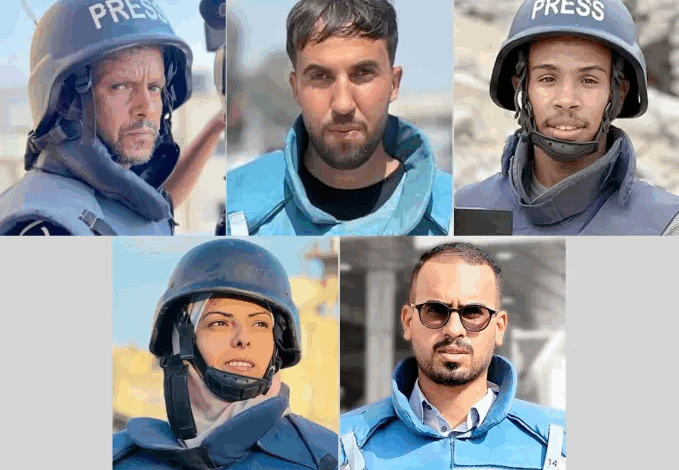New Video Shows Israeli Forces Carried Out Three Strikes, Not Two, on Gaza Hospital, Killing 22 Including Five Journalists

Gaza (Quds News Network)- New video footage reveals that the second Israeli strike on Gaza’s Nasser Hospital on Monday was actually two back-to-back strikes, CNN reported on Thursday. The attacks killed 22 people, including five journalists and a rescue worker.
The Israeli attack on the hospital came just after 10 a.m. local time on Monday when a balcony at the Nasser Hospital in Khan Younis was hit by what appears to be a tank shell, killing Reuters cameraman Hussam Al-Masri and others.
Nine minutes later, as a group of rescue workers and other journalists came to the scene, they were hit as the Israeli military fired again on the hospital at 10:17 a.m. local time, a tactic known as a “double tap,” CNN revealed.
New video obtained by CNN showed that this second “tap” was in fact two near-simultaneous strikes. These second and third strikes appear to have caused most of the deaths.
A frame-by-frame analysis of another video obtained by CNN of the same moment makes it clear that two more munitions were fired at the hospital. One shell hits the staircase where first responders had gathered; a fraction of a second later, another explodes at almost the same spot.
The two near-simultaneous shells seen in the new video are likely to be from “multi-purpose” tank guns, such as the Israeli M339 model, according to an analysis by weapons specialist N.R. Jenzen-Jones, who is the director of Armament Research Services. The damage seen following the strikes is consistent with this type of munition, he said, “with clear evidence of blast and fragmentation damage.”
“The impact of two projectiles at nearly the exact same moment suggests two tanks may have fired on the target simultaneously,” Jenzen-Jones told CNN.
“It’s hard to read too much into that, but it suggests a more carefully coordinated attack, rather than a single vehicle firing at a ‘target of opportunity’. Modern tank guns, supported by the sensors and systems of modern tanks, are very precise.”
The fourth-floor balcony and staircase area of the Nasser Hospital was frequently used as a live camera position by Reuters, the Associated Press and other global media outlets. The location was also known to be used by journalists searching for cell signal to upload their material.
Video shows the projectiles that hit the hospital staircase were coming from the northeast and were consistent with tank shells, according to an analysis by Trevor Ball, a former US Army senior explosive ordnance disposal team member. The aftermath of the strikes is also consistent with fragmentation damage from tank shells such as the M339 model, Ball told CNN.
A satellite image taken by Planet Labs on August 22 shows more than a dozen combat vehicles, including tanks, at an Israeli military base a mile-and-a-half northeast of Nasser Hospital. Multiple other Israeli military bases are further northeast, as well as in other directions. It is not clear whether the shells came from those nearby tanks or from another Israeli position.
Among the victims were five journalists:
- Hussam Al-Masri, Reuters photojournalist
- Mohammed Salama, Al Jazeera photojournalist
- Mariam Abu Daqqa, journalist with Independent Arabia and AP
- Moath Abu Taha, journalist with NBC News
- Ahmed Abu Aziz, journalist with Quds Feed
- Other victims included Mohammad Al-Habibi, a sixth-year medical student, and Imad Al-Shaer, a civil defense firefighter and father of three.
Israeli soldiers claimed that there was a camera that was used by Hamas to monitor military movements. They fired a second shell to “confirm the hit.” That strike landed on rescue teams and doctors treating the injured.
The Israeli army said the Chief of Staff ordered a preliminary investigation, claiming that the army “does not target journalists”.
Live footage from the hospital showed journalists standing on the stairs before they were hit in the second strike.
Later on the same day, Israeli forces targeted journalist Hasan Dohan while he was inside his tent in Al-Mawasi.
On Tuesday, the Israeli military claimed that its “initial investigation” into its own attack on the southern Gaza hospital showed that the target was a camera positioned in the area and used by Hamas to monitor Israeli troop movements.
“In light of this, the force acted to destroy the camera,” the Israeli army said.
The Israeli military also claimed that it targeted and killed six fighters in the attack.
In a statement on Wednesday, Hamas challenged the Israeli government’s account that claimed to name six fighters killed in the attack.
Hamas said that at least two of the six Palestinians named by the Israeli military were not killed in the shocking double strike on the hospital, but at other times and locations, including one who was killed in al-Mawasi, some distance from the hospital in Khan Younis.
Gaza’s Government Media Office also refuted the claims.
The Office noted that the moment of the initial Israeli strike, a Reuters news agency live video feed, which cameraman Hussam al-Masri had been operating, suddenly shut down. Al-Masri was killed in the attack.
It referred to the second attack, calling it a “double-tap strike”, two strikes on the same target. The first strike is intended to kill an individual or individuals, the second to kill any rescue workers who come to help. The Office added the strike breaches of the 1949 Geneva Conventions, which prohibit the targeting of medics, anyone assisting in rescue efforts or those wounded in the first strike.
In fact, Monday’s strikes targeted a hospital full of medical staff, rescuers and journalists. All of them are protected under international law.
The Office also said Israel targeted and killed in the attack well-known journalists who were working with international agencies and they were not wanted.




